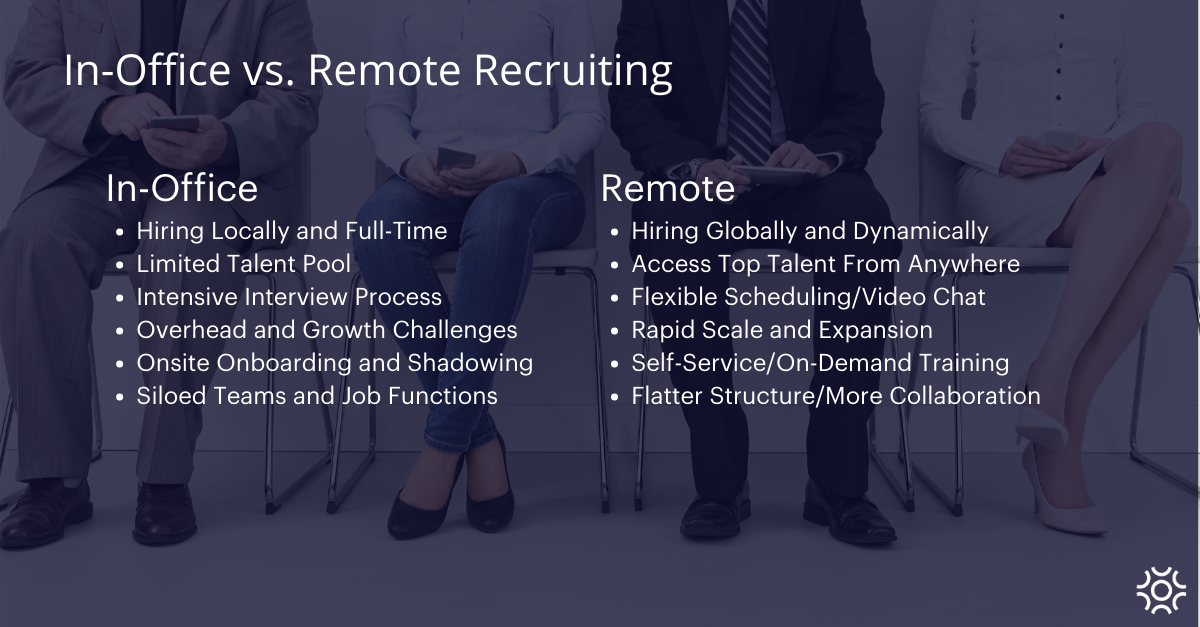Virtual hiring is a new phenomenon (and a difficult challenge) for many managers today.
Whether you’re looking to fill full-time roles in-house or leverage freelance or on-demand talent for specific projects, it’s important to understand the nuances—and benefits—of virtual talent management.
In Braintrust’s eBook Innovation from Anywhere: The Playbook for Running Remote, we highlight some of the ways that remote recruiting can be even more effective than onsite:
"Staffing is actually an area that can benefit greatly when working with distributed teams, enabling hiring managers and organizations to focus on attracting the best available candidates for a particular role regardless of their geographic location or other traditional barriers.
Virtual hiring (particularly of freelancers and project-based talent) is also a great way to quickly fill specialized roles that are needed to complete specific initiatives."
Consider the following ways that virtual recruiting and talent sourcing can benefit organizations struggling to attract or retain top talent onsite:

Learning from the Experts
To discuss the topic in more detail, Braintrust co-founder Gabe Luna-Ostaseski recently sat down with GitLab's Head of Remote Darren Murph. GitLab is the world’s largest all-remote company with 1,200 people in over 65 countries and regions, and Darren is at the helm of their people operations.
GitLab’s Remote Playbook has some excellent tips for overcoming the virtual divide, and stresses that leaders need to acknowledge the significant transition from onsite to remote, and can’t expect success overnight:
“Remember that transitioning to remote, even if temporary, is a process. You cannot copy an in-office environment and paste it into a remote one expecting everyone to function as usual.
It's important to over communicate with your team as you adjust. Speak up about issues. Offer solutions for communication gaps. Seek advice on how others have carved out dedicated places of work within their home. Crowdsource advice from within your organization.”
As managers move out of crisis mode and return to their roadmaps, many are being tasked with hiring to fill key roles virtually. During a recent webinar we polled leaders from Fortune 1,000 companies and found that 42% of participants had never hired or onboarded a candidate without meeting them in person.
Even in “normal" times many interviews are done via phone or teleconference—bringing someone onsite is only the final step, the coup de gras, the sanity check, the critical, “do they fit in here?” test.
Seeking Culture Values Fit
“People generally buy with emotion and justify with logic, and this is true for hiring as well… especially face-to-face,” says Murph. “Remote forces you to break that down… it helps you remove bias.”
Darren went on to explain that the team at GitLab doesn’t actually don’t hire for culture fit— they hire for values fit. “If you’re trying to hire and you don’t have well-articulated values, you will forever struggle on culture fit,” he noted.
In a traditional office environment, you might look for someone who will “get along” with the team; someone who's fun, sociable, charismatic and create will contribute to a good “office vibe.”
When working remotely, these soft skills become less critical—and core values like work ethic, honesty, passion, and drive end up determining whether a candidate will be a good fit.
Ask yourself: will this person do the right thing even if no one is looking?
Having a distributed team requires a level of trust, ownership and autonomy that might feel new to folks who have spent most of their career in an office. At Braintrust, our core values and tactics are central to the way we manage our daily work, and are regularly reinforced in team meetings and with recognition for team members that embody and demonstrate them.
Darren urged our event participants to get crystal clear on their values BEFORE making any hires. Prospective candidates should be able to see and review these prior to applying or interviewing, to avoid wasting time and effort for both parties.

HYPER Communication
Communication is critical to success when working remotely. Much of the team’s work will be done asynchronously, and how clearly (and concisely) someone writes and email or articulates an idea in a meeting can significantly accelerate or hinder progress for the team.
To assess communication capability, Murph recommends asking prospective candidates to tell a story about a time when they worked remotely.
[Hint: Whether they realize it or not, most people have worked remotely in some capacity; at a hotel during a conference, on a plane or at an airport, even at a local coffee shop. When interviewing candidates who are “new” to remote work, ask about these types of examples and how they’ve continued to move projects forward despite being out of the office.]
Independent Problem Solving
This isn’t going away. Darren suggested the world’s embrace and recognition of remote work has been accelerated by at least 10 years in response to COVID-19. So when making a new hire, you need to look for someone who is able to work autonomously and operate independently.
Distributed employees can’t walk up to someone else's desk and ask for a quick clarification. And, if that behavior translates virtually to sending a message/email/text to colleagues or managers every time they have a question, they'll end up creating costly interruptions to productivity.
To assess a candidate’s level of independence, we suggest asking the candidate to walk you through a project they owned from start to finish. What was the challenge, what was their approach to solving it, what resources were essential to success, what roadblocks did they encounter, and what was the outcome?
Much like the WFH scenario, everyone has run a project at some point, even something as simple as implementing a new filing system.
What you’re looking for is a candidate who can see the whole picture and articulate the steps in the process, and how they moved things forward with uncertain or ambiguous facts. Really take the time to dig here and uncover what they themselves owned and implemented vs. something that was a top down directive.
Final Thoughts
Distributed work enables hiring managers and organizations to focus on attracting the best available candidates for a particular role regardless of their geographic location or other traditional barriers.
Virtual hiring (particularly of freelancers and project-based talent) is a great way to quickly fill specialized roles that are needed to complete specific initiatives.
GitLab has some tremendous resources for hiring remotely, including how to work remote-first and onboard virtual hires.
You can click here to download your copy of Innovation From Anywhere: The Playbook for Running Remote.
Bonus Offer: To help you streamline and improve the onboarding process for new virtual hires, we've created a plug-and-play checklist you can easily customize and use in your business. Click here to download your copy.
This is the fourth post in a five-part series dedicated to helping organizations successfully build, leverage and scale distributed teams.Read parts one, two and three.




